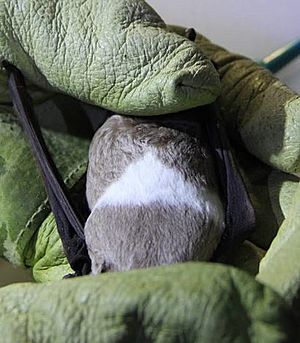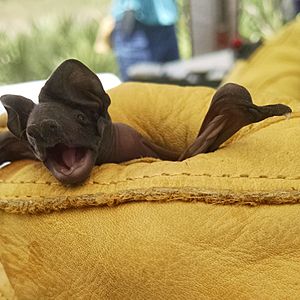Florida bonneted bat facts for kids
Quick facts for kids Florida bonneted bat |
|
|---|---|
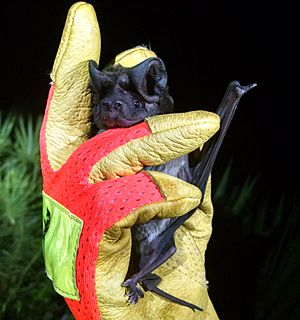 |
|
| Conservation status | |
| Scientific classification | |
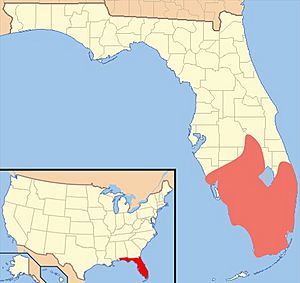 |
|
| Range of the Florida bonneted bat based on 2017 study | |
| Synonyms | |
|
The Florida bonneted bat (also called the Florida mastiff bat) is a special kind of bat. It belongs to a group of bats known as Eumops, which are often called bonneted bats or mastiff bats.
Not long ago, scientists thought it was just a type of Wagner's bonneted bat. But now we know it's its own unique species. This bat lives only in southern Florida in the United States. It has one of the smallest living areas of any bat in North or South America.
Many people call it "one of the most critically endangered mammal species in North America." This means it's in great danger of disappearing forever. Because of this, it is protected by the Endangered Species Act.
Contents
Discovering the Florida Bonneted Bat
Scientists first found a fossil of a bonneted bat in Florida in 1922. It was a jawbone from a very long time ago, during the Pleistocene Ice Age. At first, they thought it was a new type of bat.
Later, in 1936, a live bonneted bat was found in a high school in North Miami. People thought it might have accidentally arrived from Cuba. But over time, more bats were found, showing they actually lived and raised families in Florida.
In 2004, after studying the bats' skulls, body size, and wing measurements, scientists realized the Florida bonneted bat was different enough to be its own species. That's when it officially became Eumops floridanus.
What Does the Florida Bonneted Bat Look Like?
This bat is the largest bat found in Florida. Adult bats usually weigh between 40 and 65 grams (about 1.4 to 2.3 ounces). Both male and female bats are about the same size. Their forearms, which are part of their wings, are about 60 to 65 millimeters (about 2.4 to 2.6 inches) long.
Their wings are long and narrow, which helps them fly very fast. Like other free-tailed bats, their tail sticks out far past the membrane that connects their legs.
The bat's fur is short and shiny, usually brownish-gray or cinnamon-brown. The hairs are lighter at the bottom and darker at the tip. Some bats even have a white stripe across their belly.
Their ears are big and point forward, making their head look a bit like it's wearing a bonnet. Male bats sometimes have a special gland on their throat. They might use this gland to mark females or their sleeping spots. Unlike many other bats in cooler places, Florida bonneted bats do not hibernate or migrate.
Where Do Florida Bonneted Bats Live?
The Florida bonneted bat lives only in southern Florida. They have been found in several counties, including Charlotte, Collier, Lee, Miami-Dade, Monroe, Okeechobee, and Polk. These bats are more often found in farm areas and places that get a lot of rain each year.
Florida Bonneted Bat Biology
Reproduction and Life Cycle
Female Florida bonneted bats usually have one baby, called a pup, at a time. Scientists have seen pregnant females in spring, summer, and early fall. Young bats have been seen almost all year round.
It seems that females can get pregnant multiple times throughout the year. However, in one group of bats, most females were pregnant in April.
Social Structure
Florida bonneted bats can live alone or in groups called colonies. Sometimes, a group will form a harem, where one male lives with many females.
Many of the groups found have more females than males. For example, one group had twenty adult females and only one adult male. The main male in a harem can often be identified by his larger size and a special gland on his throat. These harems stay together all year.
What Do Florida Bonneted Bats Eat?
The Florida bonneted bat mainly eats insects. Their diet includes different kinds of beetles, flies, and true bugs.
Natural Roosting Spots
The first natural place where a Florida bonneted bat was found sleeping was in 1979. It was inside a longleaf pine tree. The bats were using a hole that had been made by red-cockaded woodpeckers. Sadly, this tree was cut down for a highway project.
Another natural roost was found in 2013 in a longleaf pine tree. This discovery showed that the bats were living and raising young further north than previously thought. In 2015, another natural roost was found in a slash pine tree.
Artificial Roosting Spots
The first live Florida bonneted bat was found in a school building in Miami in 1936. In the 1950s, more bats, including young ones, were found in other school buildings and even in homes in Miami.
Since 2003, these bats have been using bat houses in North Fort Myers. They have continued to use these houses ever since. In 2008, bats were also found using bat houses in the Babcock-Webb Wildlife Management Area.
In 2014, a bat roost was found in the roof of an empty house in Coral Gables, Florida. This caused some discussion because the city was worried about the house's condition, but the United States Fish and Wildlife Service wanted to protect the endangered bats. The bats were safely moved from the house in December 2016 after it was confirmed there were no pups present.
Protecting the Florida Bonneted Bat
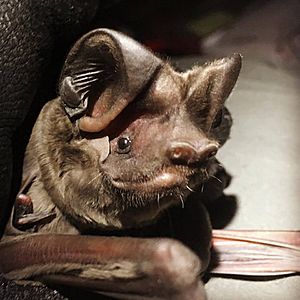
Why Their Numbers Are Declining
The Florida bonneted bat was once thought to be common along Florida's east coast. But their numbers started to drop in the 1960s and 1970s. By 1980, some even thought they were extinct.
The main reasons for their decline include:
- Their habitat (the places they live and find food) is being destroyed.
- They have a very small population.
- They live in a limited area.
- They don't have many babies.
- Their groups are often isolated from each other.
Scientists also believe that climate change and rising sea levels will cause them to lose even more of their homes and feeding grounds. Because their population is already so small, changes in weather could affect them even more.
Conservation Status and Efforts
In 2008, the International Union for Conservation of Nature (IUCN) listed the Florida bonneted bat as Critically Endangered. This is the highest level of risk for a species.
However, in 2016, the IUCN changed its assessment to Vulnerable. This change happened because there isn't a clear estimate of how many bats are left. To be "Endangered," there must be fewer than 2,500 mature bats.
The Florida Fish and Wildlife Conservation Commission still lists it as an endangered species. The United States government also listed it as a federally protected species in October 2013. In 2013, Bat Conservation International included this bat on its list of 35 top priority species for conservation around the world.



